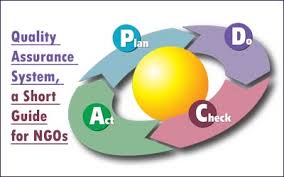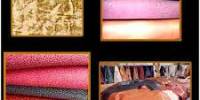Quality assurance:
Quality assurance refers to the engineering activities implemented in a quality system so that requirements for a product or service will be fulfilled.It is the systematic measurement, comparison with a standard, monitoring of processes and an associated feedback loop that confers error prevention.[2] This can be contrasted with quality control, which is focused on process outputs.
Quality assurance system can be divided into following steps:
1. On line Quality assurance system and
2. off line Quality assurance system.
Again on line Quality assurance system can be divided into the following steps:
(a) Raw material control.
(b) Process control.
Tests are done at those stages here-
1) After Scouring-Bleaching:
-PH test
-Absorbency test.
-Size test.
-Whiteness test
-Yellowness test
– Pick- up %
2)Finishing :
-Shade checking.
-Peach finish quality.
-Finish type.
-Hand feel.
Online Quality control:
Raw material control:
R.K. Group of Industry Ltd. always very concern about the quality of the product. So, they knit grey fabric from the best quality yarn & utilizes technical evaluation in every stage of the production, as we know the quality product depends on the raw material quality.
Process control:
The method chosen for process must be provided with the necessary accurate parameters. In the every stage pH should be maintained sincerely.
Lab:
Lab is the heart of a dyeing industry. An efficient lab can increase the efficiency of dyeing. So lab in-charge is sometimes called Pilot. Before bulk production a sample for approval from buyer is sent to buyer. Lab supplies the recipes to the floor.
Purpose of Lab:
- Get color approval from buyer.
- Recipe supply to the floor.
- Shade correction.
- Minimize the deviation between bulk & lab.
Machineries in Lab:
1.Dryer m/c:
Brand Name: Whirpool
Capacity: 6kg
Origin: USA
2.Washing m/c:
Brand Name: Wascator
Company Name: ATLAS
Origin: USA
3.Color fastness to wash:
Brand Name: ATLAS
Model no: M-228
Origin: USA
4. D-65 For Illumination:
Off line quality control:
After dyeing the material is received by the finishing section. Before receiving the following things are checked:
- Shade condition.
- Wash fastness.
- Condition of softening.
- Condition of enzyme wash.
Before delivery the finished fabric to the customer it should be pass against the requirements.
The following tests are done-
GSM check.
Shrinkage test.
Shade check.
Rubbing test.
Wash fastness test.
1. GSM check
The procedure for fabric weight test of finished fabric:
M/C used: G.S.M. cutter.
Frequency: Every order.
Procedure: 3 sample pieces are cut with G.S.M. cutter. Find their average wt.
- Gram per square meter (GSM)= Average wt*100
- Ounce per square meter (oz/yd2)=G.S.M.*0.0296
Performance std: According to buyer’s given std.
In case of non-conformity:
- To increase G.S.M.: Reduce width mechanically.
- To decrease G.S.M.: Increase width mechanically
2. Shrinkage test:
Testing time: After dryer or before compacting.
Equipment used: Shrinkage board, shrinkage scale, measurement tape, scissor, washing machine, detergent.
Lengthwise shrinkage = (-ve) %.
Lengthwise extension = (+ve) %.
Test method: ISO 6330:2000.
Shrinkage tolerance: ±5%.
The fabric is cut according to the shrinkage board. Then the fabric is washed by washing m/c with PCLF for 60 min. at 40. Then the shrinkage% is determined by the shrinkage scale.
3. Shade check :
Testing time: During in the process & after finishing.
Equipment used: Verivide light box.
Country of origin: U.K.
Light sources: D-65,TL-83,TL-84,F,UV.
4. Rubbing fastness test:
Fastness to rubbing is the resistance of dyed fabric to color loss by friction or rubbing.
Crocking cloth: This is a white unbleached, undyed cotton fabric. For wet rub, crocking cloth will be wetted with water and squeeze to 100% take up.
Procedure :
1. Cut the sample as long as that can cover the metallic mounting plate
2. Two specimens are required for dry rub and two for wet rub testing.
3. For both dry and wet test one specimen will be placed to warp direction and other weft direction.
4. Place the sample with tape under the metallic mountain plate
5. Then 10 x 10s (to and fro 1 rub/sec) rub is done by turning the handle.
6. Remove the crocking cloth form peg. In wet rub the crocking cloth is dried at room temperature.
Assessment:
Compare the contrast between the treated and untreated white crocking cloth with the staining grey scale and color changing with changing grey scale in a color matching cabinet.
5. Wash Fastness test:
Fastness to wash is the resistance of dyed fabric to bleed under the action of washing chemicals.
For this test the following reagents are used-
- ECE reference detergent
- Sodium Carbonate
- Distilled water
Testing Procedure:
1. The specimen measuring 10 cm x 4 cm of material is cut out.
2. Avoid specimen within 5 cm of the selvedge.
3. Cut a piece of multi-fibre 4 cm wide
4. The multi-fibre has selvedge of 10 cm long.
5. Align test specimens and multi-fibre and sew together to form a composite specimen.
There are 5 ISO standard washing fastness tests-
| Test | Temp (0C) | Time (min) | Steel balls | Reagents |
| ISO 105 CO1 | 40 | 30 | 0 | Soap (5 g/l) |
| ISO 2 | 50 | 30 | 0 | Soap (5 g/l) |
| ISO 3 | 60 | 30 | 0 | Soap (5 g/l)+ Soda (2 g/l) |
| ISO 4 | 95 | 30 | 10 | Soap (5 g/l)+ Soda (2 g/l) |
| ISO 5 | 95 | 240 | 10 | Soap (5 g/l)+ Soda (2 g/l) |
Assessments :
Compare the contrast between the treated and untreated sample with the changing grey scale and staining of multi-fibre fabric with the staining grey scale in color matching cabinet.
6. Color Fastness to Perspiration:
Equipment used: Rota-Wash.
Test Method: ISO 105E04.
















